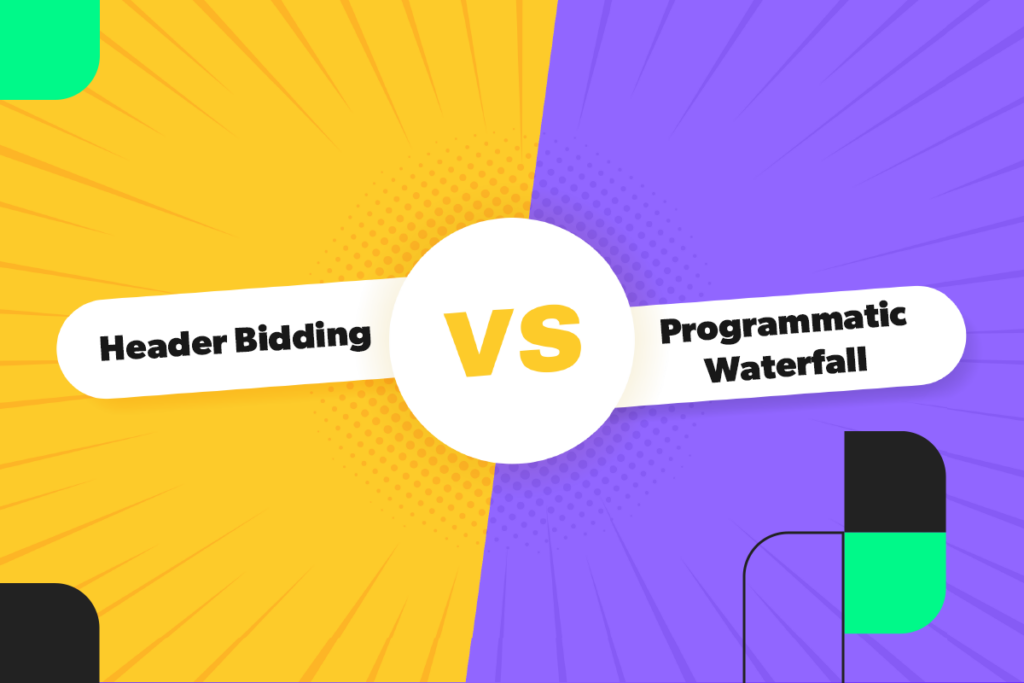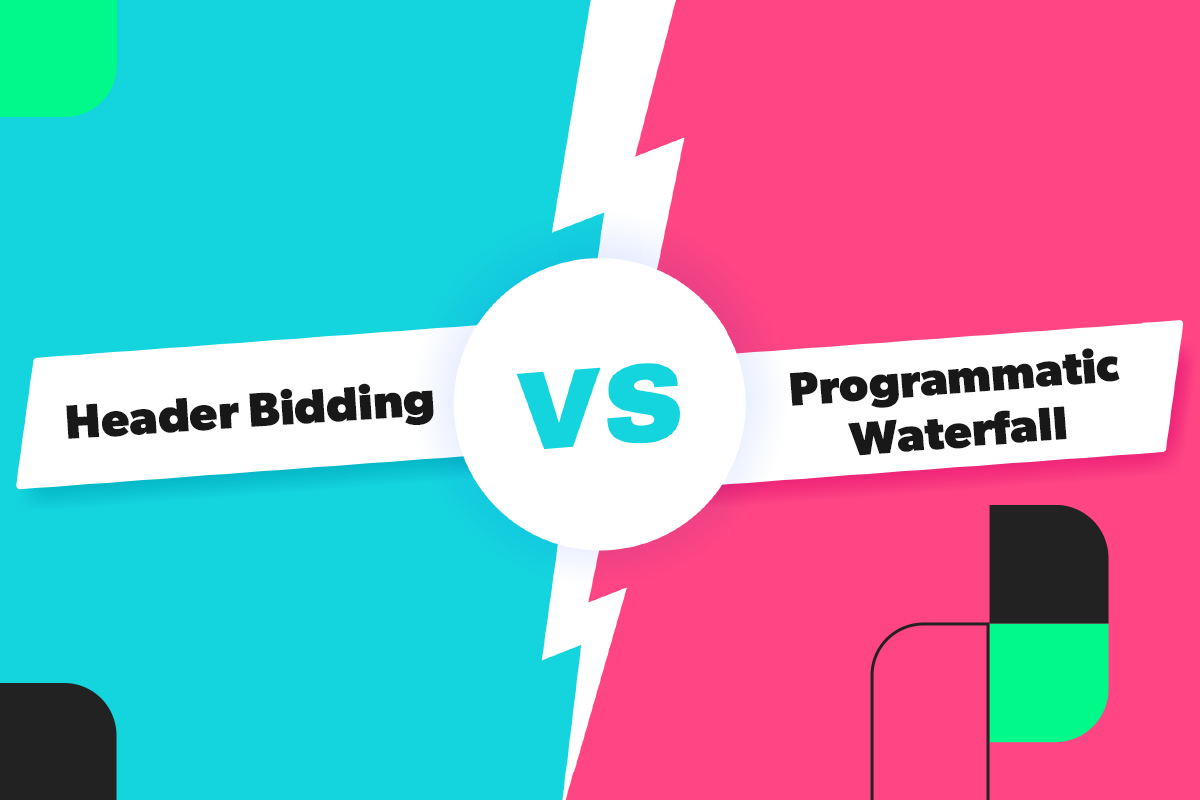Programmatic advertising has reshaped the digital advertising landscape by automating ad inventory buying and selling. As a result of this evolution from traditional ad-buying methods, digital marketing strategies have become more efficient, precise, and data-driven.In this blog post, we’ll dive into header bidding and waterfall, explaining their system, advantages and disadvantages, and best practices. Read on!
Overview of Header Bidding and Programmatic Waterfall
There are two dominant approaches to programmatic advertising (with header bidding taking the lead): header bidding and programmatic waterfall. These methods have distinct characteristics that significantly impact ad monetization strategies and overall outcomes.
Understanding the Waterfall Method
As the name implies, the waterfall system is a sequential method for selling ad inventory by cascading ad requests through different ad networks or exchanges until a suitable ad is found. The sequential process ensures that every ad request is handled in a structured manner.
Programmatic waterfalls begin with a preferred ad network, and then request ads from other networks if the first fails to deliver. This sequential process is repeated until an appropriate ad is identified and displayed. Even though waterfall is straightforward and easy to implement, it has its own set of challenges.
Advantages and Disadvantages of the Waterfall Approach
Advantages
Simplicity: The waterfall method is straightforward and easy to implement, making it accessible for publishers.
Control: The order of ad network priorities can be controlled by publishers so that preferred networks can be prioritized.
Disadvantages:
Latency: Potential delays in loading ads can impact user experience as the sequential process might take time, leading to slower page load times.
Limited Revenue Optimization: As waterfall approaches may not always select the most profitable ad, they may not maximize revenue as effectively as other techniques.

Exploring Header Bidding
Header bidding, also known as advance bidding or pre-bidding, is an auction method where publishers simultaneously offer their ad inventory to multiple ad exchanges, enabling publishers to reach more demand partners and ensure the highest bid. Header bidding triggers an auction every time a user opens a webpage. Ad exchanges and demand partners are notified within milliseconds of an ad slot’s availability, and the advertiser with the highest bid wins. On mobile apps, this is called in-app bidding.
Operational Mechanics of Header Bidding
In header bidding, a piece of code is embedded in the header of a web page or app, allowing multiple ad exchanges to submit bids at the same time. The highest bid is then selected, and the winning ad is displayed. This process enables publishers to access a broader pool of advertisers and select the highest-paying ad in real-time.
Benefits and Challenges of Implementing Header Bidding
Benefits:
Maximized Revenue: Header bidding enables publishers to sell more ad space and get the highest bid for their inventory, maximizing revenue potential.
Transparency: Publishers and advertisers benefit from header bidding since it fosters fair competition and transparency.
Optimization: Header bidding enables advertisers to access impression data to optimize their campaigns better.
Challenges:
Latency Concerns: When multiple bids are made simultaneously, the page load time may be slowed, affecting the user experience. Efforts are made to mitigate this challenge through optimization.
Technical Complexity:
Compared to waterfall bidding, header bidding requires a more sophisticated technological setup. Publishers must ensure seamless integration and ongoing management of their systems.
Header bidding has gained prominence due to its potential for revenue optimization and improved transparency in the bidding process. Even though it comes with its challenges, its benefits often outweigh its drawbacks.
The Transition from Waterfall to Header Bidding
Header bidding has been adopted as a result of several industry trends, which reflect greater sophistication and transparency in ad buying. Here are a few key trends:
- Increased Demand for Transparency: There has been a growing demand for more transparency in ad buying from both advertisers and publishers. The header bidding process allows both parties to see how ad inventory is valued, giving them a clearer picture of the bidding landscape.
- Real-Time Bidding Dynamics: The rise of real-time bidding (RTB) has contributed to the popularity of header bidding. Digital advertising is dynamic, so the ability to gather bids from multiple sources in real time is essential.
- Growing Importance of Data:
It is possible to target audiences more precisely with header bidding. With the increasing emphasis on data-driven advertising, publishers are leveraging header bidding to access richer sets of data for precise ad targeting. - Competitive Landscape: Advertisers are keen to ensure their bids are considered in real-time against competitors. Header bidding fosters a more competitive environment, encouraging advertisers to submit their best bids to secure premium ad placements.

How Publishers and Advertisers Are Adapting?
The shift to header bidding requires adaptation to header bidding involving strategic adjustments by both publishers and advertisers. Among the key considerations are:
- Investment in Technology: The ad tech industry is investing in sophisticated solutions for seamless header bidding integration and management. This involves selecting or developing platforms that align with their specific needs.
- Education and Training: In order to make informed decisions about header bidding, publishers and advertisers are educating their teams.
- Dynamic Pricing Strategies: As advertisers compete in the real-time bidding environment, they adapt their pricing strategies accordingly. This involves analyzing data and adjusting bids based on performance.
- Continuous Optimization: Publishers and advertisers are both adopting a continuous optimization mindset. For maximum revenue and efficiency, it is important to review and refine header bidding setups on a regular basis.
Best Practices for Implementing Header Bidding in Mobile Apps
Preparing Your Tech Stack for Header Bidding
Implementing header bidding successfully in mobile apps requires a robust technical infrastructure. Here’s an outline of the necessary components for a successful implementation:
- Ad SDK Integration: You should ensure seamless integration with your ad SDK. The header bidding solution should effectively communicate with the ad SDK to request, process, and display bids within the app environment.
- Header Bidding Wrapper for Mobile: You may want to consider using a header bidding wrapper specifically designed for in-app environments. Among the most popular wrappers for mobile apps are Prebid Mobile and PubMatic’s OpenWrap SDK.
- Responsive Design for Mobile: You should optimize your mobile app for responsive design to accommodate header bidding without compromising the user experience. Responsive design ensures a smooth auction process across various mobile devices.
- Data Management Platform (DMP) for Mobile: Utilize a mobile-friendly DMP to collect, analyze, and leverage audience data for more precise targeting within your mobile app. This enhances the value of your in-app ad inventory and attracts higher bids.
- Page Load Optimization for Mobile: Optimise your mobile application’s ad loading times to minimize latency concerns. Implement asynchronous loading of header bidding scripts and strategically place them to minimize the impact on user experience.

Managing and Optimizing Header Bidding Setups
Once header bidding is implemented in your mobile app, ongoing management and optimization are essential. These guidelines will help you manage and optimize header bidding setups within mobile apps:
- Performance Monitoring for Mobile Apps: Make sure you are continuously monitoring the header bidding performance within your mobile app. Determine areas for improvement specific to the mobile environment by tracking metrics such as fill rates, latency, and revenue.
- Bidder Evaluation for Mobile Apps: Monitor different bidders’ performance in your mobile app regularly. It is important to consider factors such as the density of bids, the win rates, and the overall contribution to revenue. Adjust bidder priorities based on mobile-specific performance.
- Header Bidding Analytics for Mobile Apps: To gain deeper insights into auction dynamics in a mobile environment, utilize header bidding analytics tools designed specifically for mobile apps. Identify the bidders’ behavior, the bids’ response time, and the competitiveness of auctions on mobile devices.
- A/B Testing for Mobile Apps: Implement A/B testing for different configurations within your mobile app. Identify the most effective mobile setup by experimenting with timeout settings, floor prices, and bidder priorities.
The Role of Ad Exchanges and SSPs in Header Bidding for Mobile Apps
Ad Exchanges in Header Bidding for Mobile Apps
- Facilitating Auction Dynamics: Ad exchanges are marketplaces where publishers and advertisers can engage in real-time bidding. Header bidding occurs almost instantaneously for mobile apps, allowing multiple demand sources to compete for impressions.
- Offering Access to Demand Partners: Various demand partners are available to publishers through ad exchanges.This inclusivity is crucial in the mobile app environment, where different advertisers and demand-side platforms (DSPs) are vying to display their ads to targeted mobile audiences.
- Ensuring Transparency: Transparency is a key consideration in header bidding, and ad exchanges play a pivotal role in providing this clarity. By facilitating a transparent and fair auction process, all demand partners are able to see the bids and publishers can gauge the value of their inventory.
- Technology Integration: Publishers’ mobile apps can be integrated with ad exchanges through header bidding wrappers or SDKs (Software Development Kits). Through these integrations, bid requests and responses are able to flow seamlessly within the mobile app environment, ensuring a smooth auction process.
- Fee Structures: When choosing an ad exchange partner, publishers need to take their fee structure into consideration. A transparent fee model is essential for publishers to understand how much revenue their mobile apps will retain from ad impressions.
SSPs in Header Bidding for Mobile Apps
- Real-Time Decisioning: SSPs are crucial in the real-time decision-making process within the header bidding setup for mobile apps. They evaluate bids from multiple demand partners and determine the winning bid based on parameters such as bid values, targeting criteria, and overall campaign goals.
- Header Bidding Wrapper Integration: In many cases, SSPs offer header bidding wrapper solutions that are specifically designed for mobile apps. The wrappers simplify the integration process for publishers, offering a unified solution for managing bids from various demand sources. This eases the technical complexities of header bidding
- Unified Auctions: SSPs are moving towards unified auctions in the era of header bidding. This approach involves auctioning both direct-sold and programmatic inventory simultaneously, providing a comprehensive view of demand. Publishers can maximize revenue potential through unified auctions.
- Optimization Tools for Mobile Apps: SSPs offer optimization tools designed for mobile apps. With these tools, publishers can fine-tune their header bidding configurations, including bid analytics, bidder prioritization, and floor price optimization. The features are designed to improve performance and revenue outcomes.
Conclusion
The strategic choice between header bidding and waterfall is crucial in programmatic advertising’s dynamic world and the industry’s siding with header bidding. The waterfall may cause latency issues and revenue limitations despite its sequential simplicity and control. In contrast, header bidding’s simultaneous approach maximizes revenue potential and transparency, requiring a more sophisticated setup. A successful adaptation strategy depends on education, technology investment, and dynamic pricing. It is vital to have a robust technology stack, header bidding wrappers, and optimization tools when implementing ads in mobile apps. SSPs play a key role in real-time decision-making and optimization, while ad exchanges facilitate auctions and ensure transparency.



